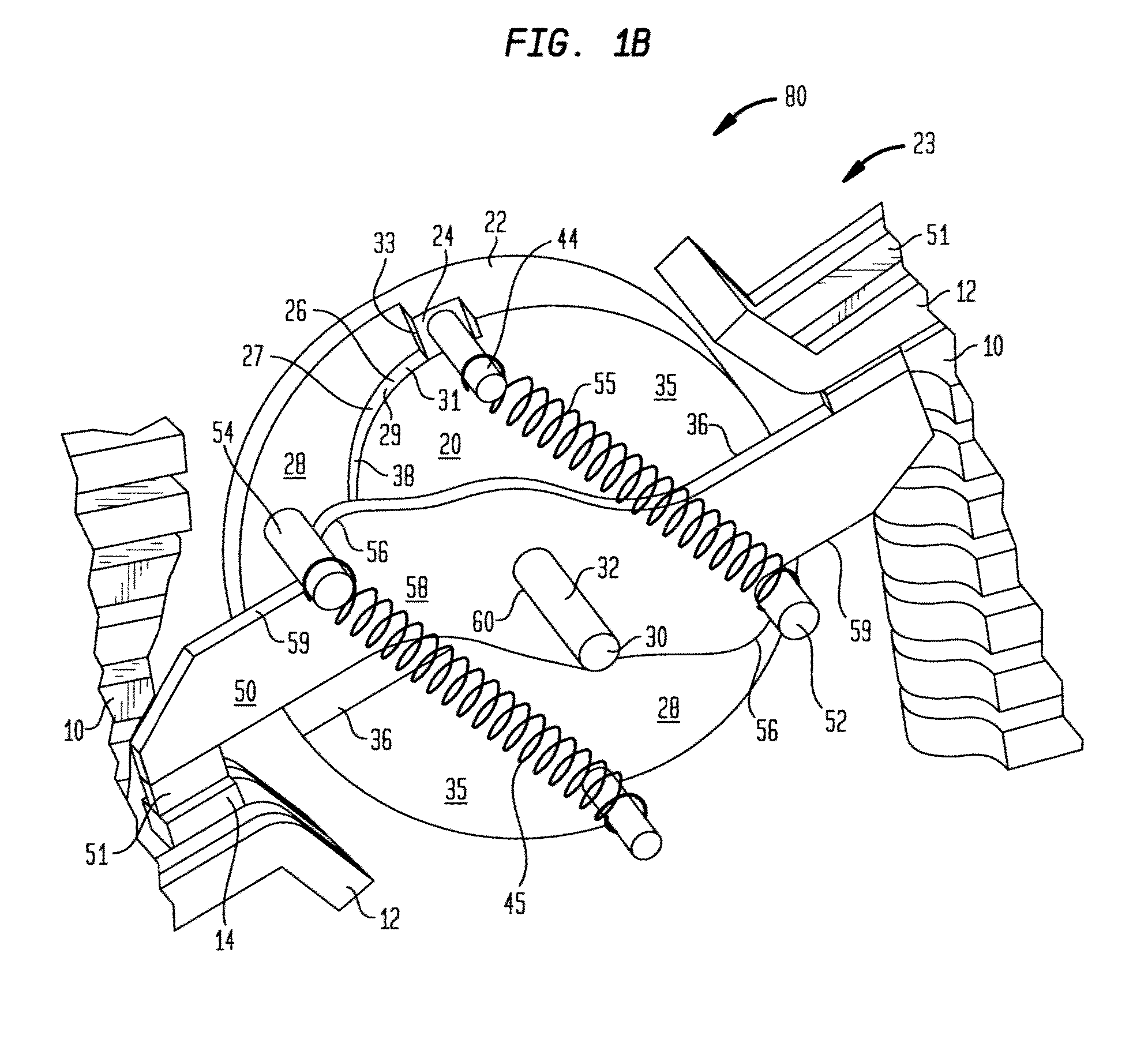Double Break Disconnect/Contact System
a contact system and double break technology, applied in the direction of circuit breaking switches, circuit breaking switches for excess current, snap-action arrangements, etc., can solve the problems of significant hysteresis, contact force between fixed and moveable contacts in the on position to be compromised, and the functional performance of such conventional mechanisms is typically affected, so as to reduce or eliminate friction, reduce or eliminate hysteresis and mechanism performance dependency, and ensure the effect of stability
- Summary
- Abstract
- Description
- Claims
- Application Information
AI Technical Summary
Benefits of technology
Problems solved by technology
Method used
Image
Examples
first embodiment
[0043]FIG. 1A is a perspective view of the inventive contact mechanism assembly for a circuit breaker 23, illustrating the present invention showing the contact mechanism inside a cassette housing 100, with a contact arm 50, in an ON position 50, and then in a blow-off position 50′.
[0044]FIG. 1B is a perspective view of the inventive contact mechanism assembly for a circuit breaker 23, illustrating a first embodiment of the present invention showing the contact mechanism and the contact arm 50, in the ON position 50.
[0045]FIG. 2A is a perspective detailed view of one half of the crossbar module 80, of the inventive contact mechanism assembly for a circuit breaker 23, illustrated in FIG. 1.
[0046]FIG. 2B is a perspective detailed view of both halves of the crossbar module 80 or of a crossbar module 80 made of one piece, of the inventive contact mechanism assembly for a circuit breaker 23, illustrated in FIG. 1.
[0047]FIG. 2C is a perspective detailed view of one half of the crossbar mo...
second embodiment
[0054]FIG. 5B is an enlarged detailed view showing a contact arm 150, that can be used with this invention.
[0055]Now referring to FIGS. 1A through 5B, the inventive contact mechanism assembly for a circuit breaker 23, comprises an arc extinguishing mechanism 10, a pair of fixed contact assemblies 12, each having a fixed contact pad 14. A contact arm assembly 50, having a movable contact 51, a contact arm body 58, contact arm edge-surfaces 59, a bump or notch or hook or structural stop 56, and a slotted hole or opening 60, which encompasses a central pivot axle 32, which is fixed / secured to the crossbar module 80. The contact arm assembly 50 is flexibly connected to the crossbar module 80 using either one or two pairs of springs, namely, a first spring 45, and a second spring 55, such that one end of the first spring 45, is secured to a fixed pin or anchor 42, which is secured to the crossbar module 80, and the other end of the first spring 45, is secured to a sliding pin 54, which i...
third embodiment
[0076]FIG. 8 is a side view of the inventive contact mechanism assembly for a circuit breaker 323, illustrating the present invention showing the contact arm 350, in an ON-position 350, and then in a blow-off position 350′.
[0077]FIG. 9 is a top view of the inventive contact mechanism assembly for a circuit breaker 323, illustrated in FIG. 8.
[0078]Now referring to FIG. 8, and FIG. 9, the crossbar module 380, central pivot axle 332, moveable contacts 351, and fixed contact assemblies 12, two sliding pins or rollers 352, 354, and two anchor pins 342, 344, are correspondingly identical to those described for the preferred embodiment of FIGS. 1A through 5B.
[0079]A split contact arm assembly 350, identical to the one described for the second embodiment described in FIGS. 6 and 7.
[0080]The split version of the contact arm 350, which consists of two symmetrical formed halves, that are secured together, such as, by brazing or welding or by other methods, to form a contact arm assembly 350, w...
PUM
 Login to View More
Login to View More Abstract
Description
Claims
Application Information
 Login to View More
Login to View More - R&D
- Intellectual Property
- Life Sciences
- Materials
- Tech Scout
- Unparalleled Data Quality
- Higher Quality Content
- 60% Fewer Hallucinations
Browse by: Latest US Patents, China's latest patents, Technical Efficacy Thesaurus, Application Domain, Technology Topic, Popular Technical Reports.
© 2025 PatSnap. All rights reserved.Legal|Privacy policy|Modern Slavery Act Transparency Statement|Sitemap|About US| Contact US: help@patsnap.com



